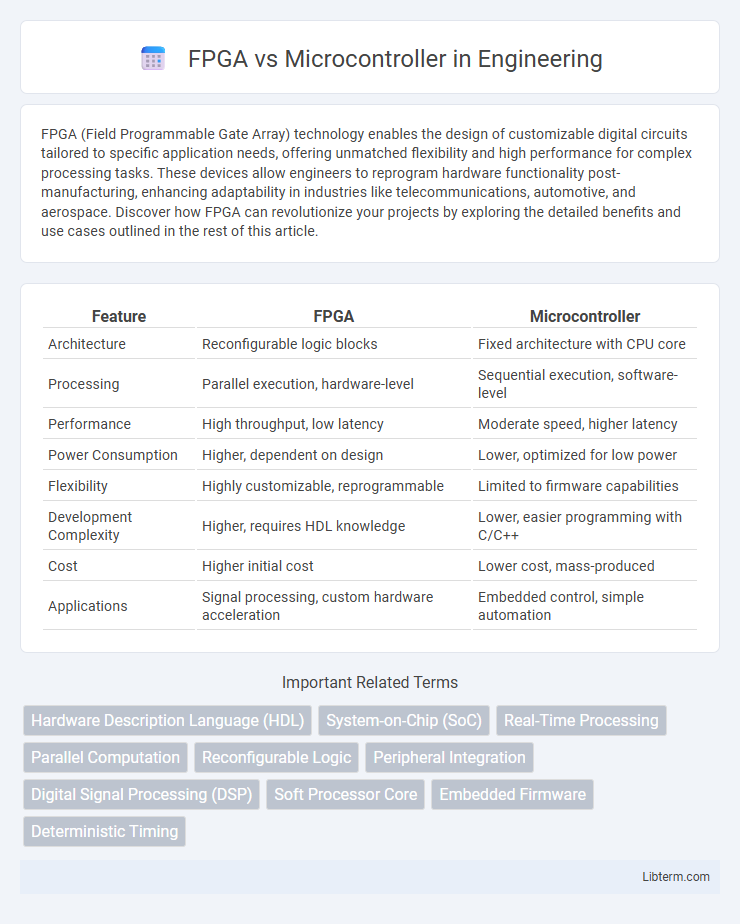FPGA (Field Programmable Gate Array) technology enables the design of customizable digital circuits tailored to specific application needs, offering unmatched flexibility and high performance for complex processing tasks. These devices allow engineers to reprogram hardware functionality post-manufacturing, enhancing adaptability in industries like telecommunications, automotive, and aerospace. Discover how FPGA can revolutionize your projects by exploring the detailed benefits and use cases outlined in the rest of this article.
Table of Comparison
| Feature | FPGA | Microcontroller |
|---|---|---|
| Architecture | Reconfigurable logic blocks | Fixed architecture with CPU core |
| Processing | Parallel execution, hardware-level | Sequential execution, software-level |
| Performance | High throughput, low latency | Moderate speed, higher latency |
| Power Consumption | Higher, dependent on design | Lower, optimized for low power |
| Flexibility | Highly customizable, reprogrammable | Limited to firmware capabilities |
| Development Complexity | Higher, requires HDL knowledge | Lower, easier programming with C/C++ |
| Cost | Higher initial cost | Lower cost, mass-produced |
| Applications | Signal processing, custom hardware acceleration | Embedded control, simple automation |
Introduction to FPGA and Microcontroller
Field-Programmable Gate Arrays (FPGAs) are integrated circuits that can be configured post-manufacturing to perform complex digital computations with parallel processing capabilities. Microcontrollers are compact integrated circuits designed for specific control applications, featuring a central processing unit (CPU), memory, and input/output peripherals on a single chip. While FPGAs excel in customizable hardware acceleration and real-time processing, microcontrollers are optimized for cost-effective, low-power embedded control tasks.
Architecture Overview: FPGA vs Microcontroller
FPGA architecture consists of a matrix of configurable logic blocks (CLBs) interconnected via programmable routing, allowing parallel processing and dynamic hardware reconfiguration. Microcontroller architecture integrates a fixed CPU core, memory units, and peripheral interfaces on a single chip, optimized for serial processing and embedded control tasks. FPGAs offer flexible hardware customization, while microcontrollers provide efficient, pre-defined instruction execution for real-time applications.
Performance Comparison
FPGAs deliver superior parallel processing capabilities compared to microcontrollers, enabling high-speed execution of complex algorithms in real-time applications. Microcontrollers, with fixed architecture and sequential processing, generally exhibit lower throughput but excel in low-power, cost-sensitive embedded control tasks. Performance metrics such as latency, throughput, and power efficiency highlight FPGAs' advantage in computation-intensive and deterministic environments.
Flexibility and Customization
FPGAs offer unparalleled flexibility and customization by allowing designers to configure hardware logic circuits tailored to specific application requirements, enabling parallel processing and real-time reconfigurability. Microcontrollers provide fixed architecture with predefined peripherals, limiting customization but simplifying development for standard control tasks and embedded applications. The ability to implement custom data paths and specialized processing units on FPGAs makes them ideal for complex, performance-critical systems, whereas microcontrollers excel in cost-effective, low-power solutions with straightforward functionality.
Power Consumption Analysis
FPGA power consumption varies significantly with workload complexity and clock frequency, often higher than microcontrollers during intensive parallel processing but more efficient for specific tasks due to dynamic power gating. Microcontrollers typically exhibit lower static and dynamic power consumption in general-purpose applications, benefiting battery-powered and low-energy systems. Analyzing power profiles in targeted use cases reveals FPGAs excel in flexibility and throughput, while microcontrollers maintain energy efficiency in simpler, sequential operations.
Development Tools and Ecosystem
FPGA development tools like Xilinx Vivado and Intel Quartus provide extensive hardware description language (HDL) support for designing custom logic circuits, enabling fine-grained control over hardware performance. Microcontroller ecosystems typically feature integrated development environments (IDEs) such as Microchip MPLAB or STM32CubeIDE, which focus on firmware programming with libraries and real-time operating system (RTOS) integration for rapid application development. FPGA ecosystems often include IP cores and simulation tools for hardware validation, whereas microcontroller platforms emphasize peripheral drivers and middleware suited for embedded software development.
Cost Considerations
FPGAs typically incur higher initial costs due to complex design tools and longer development cycles compared to microcontrollers, which benefit from lower unit prices and straightforward programming environments. Microcontrollers offer cost-effective solutions for mass production with consistent pricing, whereas FPGA costs vary widely based on logic density and customization requirements. Choosing between FPGA and microcontroller depends on balancing upfront investment against performance needs and production volume economics.
Typical Applications
FPGAs excel in high-speed data processing, real-time signal processing, and complex hardware emulation tasks, commonly used in telecommunications, aerospace, and advanced robotics. Microcontrollers are preferred for embedded control applications such as automotive systems, home automation, and consumer electronics due to their ease of programming and low power consumption. The choice between FPGA and microcontroller depends on the need for parallel processing capabilities versus simple, cost-effective control solutions.
Design Complexity and Learning Curve
FPGA design involves complex hardware description languages (HDLs) such as VHDL or Verilog, requiring a deeper understanding of digital logic and parallel processing, which contributes to a steeper learning curve compared to microcontrollers. Microcontrollers use simpler programming languages like C or Python, making their development environment more accessible for beginners and suitable for sequential task execution. The design complexity of FPGAs enables customizable hardware acceleration, while microcontrollers excel in straightforward control applications due to their integrated peripherals and simpler architecture.
Choosing the Right Solution
Selecting between FPGA and microcontroller depends on application requirements such as processing speed, flexibility, and power consumption. FPGAs offer parallel processing and customizable hardware, ideal for high-performance, real-time tasks, while microcontrollers excel in low-power, cost-sensitive embedded systems with simpler control logic. Evaluating factors like latency, development complexity, and scalability ensures choosing the right solution for efficient and effective design implementation.
FPGA Infographic

 libterm.com
libterm.com